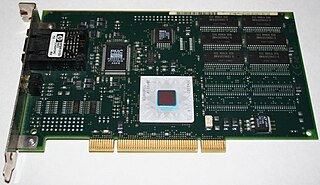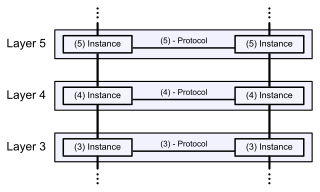Connection-Oriented Network Service (CONS) is one of the two Open Systems Interconnection (OSI) network-layer protocols, the other being Connectionless-mode Network Service (CLNS). It is basically X.25, with a few[ which? ] adjustments.
Connection-Oriented Network Service (CONS) is one of the two Open Systems Interconnection (OSI) network-layer protocols, the other being Connectionless-mode Network Service (CLNS). It is basically X.25, with a few[ which? ] adjustments.
Some protocols that provide the CONS service:

Asynchronous Transfer Mode (ATM) is a telecommunications standard defined by the American National Standards Institute and ITU-T for digital transmission of multiple types of traffic. ATM was developed to meet the needs of the Broadband Integrated Services Digital Network as defined in the late 1980s, and designed to integrate telecommunication networks. It can handle both traditional high-throughput data traffic and real-time, low-latency content such as telephony (voice) and video. ATM provides functionality that uses features of circuit switching and packet switching networks by using asynchronous time-division multiplexing. ATM was seen in the 1990s as a competitor to Ethernet and networks carrying IP traffic as, unlike Ethernet, it was faster and designed with quality-of-service in mind, but it fell out of favor once Ethernet reached speeds of 1 gigabits per second.

The Open Systems Interconnection (OSI) model is a reference model from the International Organization for Standardization (ISO) that "provides a common basis for the coordination of standards development for the purpose of systems interconnection." In the OSI reference model, the communications between systems are split into seven different abstraction layers: Physical, Data Link, Network, Transport, Session, Presentation, and Application.
A virtual circuit (VC) is a means of transporting data over a data network, based on packet switching and in which a connection is first established across the network between two endpoints. The network, rather than having a fixed data rate reservation per connection as in circuit switching, takes advantage of the statistical multiplexing on its transmission links, an intrinsic feature of packet switching.

X.25 is an ITU-T standard protocol suite for packet-switched data communication in wide area networks (WAN). It was originally defined by the International Telegraph and Telephone Consultative Committee in a series of drafts and finalized in a publication known as The Orange Book in 1976.
Signalling System No. 7 (SS7) is a set of telephony signaling protocols developed in the 1970s, which is used to set up and tear down telephone calls in most parts of the world-wide public switched telephone network (PSTN). The protocol also performs number translation, local number portability, prepaid billing, Short Message Service (SMS), and other services.

In computer networking, the transport layer is a conceptual division of methods in the layered architecture of protocols in the network stack in the Internet protocol suite and the OSI model. The protocols of this layer provide end-to-end communication services for applications. It provides services such as connection-oriented communication, reliability, flow control, and multiplexing.
The Message Transfer Part (MTP) is part of the Signaling System 7 (SS7) used for communication in Public Switched Telephone Networks. MTP is responsible for reliable, unduplicated and in-sequence transport of SS7 messages between communication partners.
The ISDN User Part or ISUP is part of Signaling System No. 7 (SS7), which is used to set up telephone calls in the public switched telephone network (PSTN). It is specified by the ITU-T as part of the Q.76x series.
Connectionless-mode Network Service (CLNS) or simply Connectionless Network Service is an OSI network layer datagram service that does not require a circuit to be established before data is transmitted, and routes messages to their destinations independently of any other messages. As such it is a "best-effort" rather than a "reliable" delivery service. CLNS is not an Internet service, but provides capabilities in an OSI network environment similar to those provided by the Internet protocol suite. The service is specified in ISO/IEC 8348, the OSI Network Service Definition

Link Access Procedure, Balanced (LAPB) implements the data link layer as defined in the X.25 protocol suite. LAPB is a bit-oriented protocol derived from HDLC that ensures that frames are error free and in the correct sequence. LAPB is specified in ITU-T Recommendation X.25 and ISO/IEC 7776. It implements the connection-mode data link service in the OSI Reference Model as defined by ITU-T Recommendation X.222.
The Common Management Information Protocol (CMIP) is the OSI specified network management protocol.
The Open Systems Interconnection protocols are a family of information exchange standards developed jointly by the ISO and the ITU-T. The standardization process began in 1977.
The Bearer-Independent Call Control (BICC) is a signaling protocol based on N-ISUP that is used for supporting narrowband Integrated Services Digital Network (ISDN) service over a broadband backbone network. BICC is designed to interwork with existing transport technologies. BICC is specified in ITU-T recommendation Q.1901.

ITU-T Recommendation Q.931 is the ITU standard ISDN connection control signalling protocol, forming part of Digital Subscriber Signalling System No. 1. Unlike connectionless systems like UDP, ISDN is connection oriented and uses explicit signalling to manage call state: Q.931. Q.931 typically does not carry user data. Q.931 does not have a direct equivalent in the Internet Protocol stack, but can be compared to SIP. Q.931 does not provide flow control or perform retransmission, since the underlying layers are assumed to be reliable and the circuit-oriented nature of ISDN allocates bandwidth in fixed increments of 64 kbit/s. Amongst other things, Q.931 manages connection setup and breakdown. Like TCP, Q.931 documents both the protocol itself and a protocol state machine.
A packet assembler/disassembler, abbreviated PAD is a communications device which provides multiple asynchronous terminal connectivity to an X.25 (packet-switching) network or host computer. It collects data from a group of terminals and places the data into X.25 packets (assembly). A PAD also does the reverse, it takes data packets from packet-switching network or host computer and returns them into a character stream that can be sent to the terminals (disassembly). A Frame Relay assembler/disassembler (FRAD) is a similar device for accessing Frame Relay networks.
The Signalling Connection Control Part (SCCP) is a network layer protocol that provides extended routing, flow control, segmentation, connection-orientation, and error correction facilities in Signaling System 7 telecommunications networks. SCCP relies on the services of MTP for basic routing and error detection.

H.323 is a recommendation from the ITU Telecommunication Standardization Sector (ITU-T) that defines the protocols to provide audio-visual communication sessions on any packet network. The H.323 standard addresses call signaling and control, multimedia transport and control, and bandwidth control for point-to-point and multi-point conferences.
Security service is a service, provided by a layer of communicating open systems, which ensures adequate security of the systems or of data transfers as defined by ITU-T X.800 Recommendation.
X.800 and ISO 7498-2 are technically aligned. This model is widely recognized